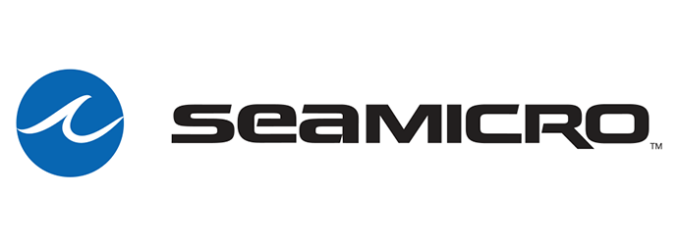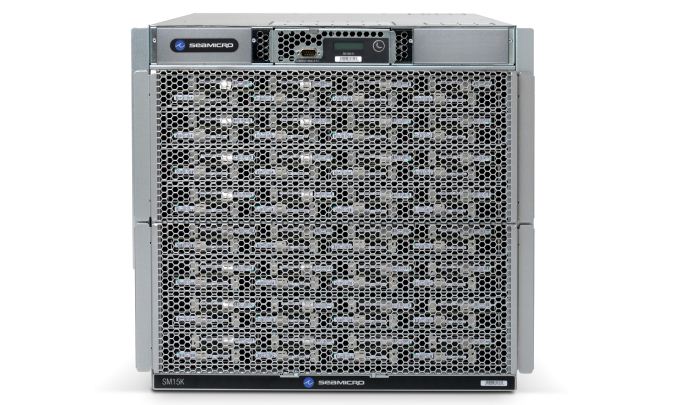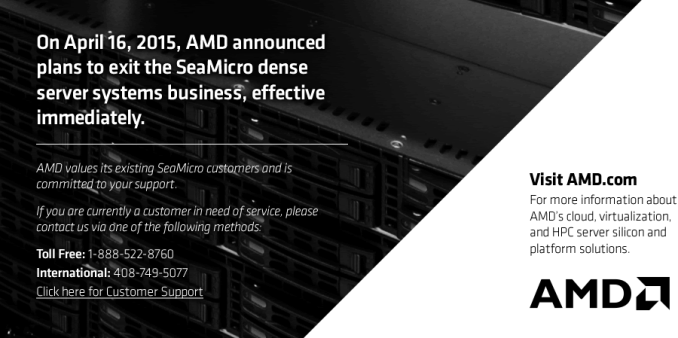AMD Exits Dense Microserver Business, Ends SeaMicro Brand
by Ryan Smith on April 16, 2015 5:30 PM EST- Posted in
- CPUs
- IT Computing
- AMD
- SeaMicro
- Microserver
- Servers

AMD’s Q1’15 earnings announcement just came out a bit ago, and while we’re still waiting for the analyst call to take place to get more details, there is one item we want to get to right away, and that’s the fate of AMD’s dense server business. As part of today’s earnings release, AMD has announced that they’re existing the dense server system business – operating under the SeaMicro brand – effective immediately.
AMD initially acquired SeaMicro back in 2012 for $334 million as part of their larger play into being an agile company, aiming to take a big chunk of what was expected to be a fast-growing market micro/dense server market. In the microserver model, servers are built using very large numbers of lower performance cores, making the servers leaner, more power efficient systems for tasks that involve large numbers of low-impact threads (think: web servers). This in turn mapped well to AMD’s processor designs, where both the Bulldozer and Cat families would be well suited for such a design, not to mention AMD’s future ARM based CPUs.
SeaMicro’s first product post-acquisition was the SM15000, a dense server design announced in late 2012 that offered either AMD “Piledriver” Opterons or Intel “Ivy Bridge” Xeon CPUs. However as it turns out that first design was also the last design; SeaMicro did not release any additional products prior to today’s announcement from AMD.
Jumping back to today, AMD’s announcement comes as the company is continuing to try to find a solid foothold as a semi-custom silicon company, to which it would appear that the SeaMicro business no longer fits into. AMD’s initial announcement does offer a bit of insight as to why they’re exiting the business – to “sharpen and simplify” what the company invests in – and we’ll likely hear more on today’s call.
Meanwhile it’s worth noting that we haven’t heard anything from SeaMicro in some time now, so today’s announcement is perhaps not all that surprising. Still, AMD’s first ARM processors were set to ship this year – the Opteron A1100 – which would have been a good fit for the SeaMicro servers. However A1100 itself appears to be behind schedule at this time, as AMD has yet to bring A1100 to market beyond last year’s development kit.
Anyhow, as part of exiting the dense server business, AMD will be taking a $75 million dollar special charge, which is “primarily related to impairment of previously acquired intangible assets” and will include a $7 million cash payment. Meanwhile AMD’s announcement doesn’t say what will become of the SeaMicro team – at this point we’re not entirely sure how large it is after AMD’s most recent restructuring – though I wouldn’t be surprised if they at least rolled some of that expertise into future ARM server CPUs. As for the SeaMicro brand itself, with AMD’s exit the brand has been shuttered, and AMD has deactivated the SeaMicro website.
Update: Here are the prepared remarks from AMD's CFO regarding SeaMicro
At the corporate level, we continue aligning larger portions of our R&D investments to take advantage of long-term growth opportunities across our EESC segment. As we prioritize our R&D investments and simplify our business, we made the decision in the first quarter to exit the dense server systems business as we increase investments in our server processor development. We retain the fabric technology as a part of our overall IP portfolio. We see very strong opportunities for next-generation, high-performance x86 and ARM processors for the enterprise, datacenter, and infrastructure markets and we will continue to invest strongly in these areas.












60 Comments
View All Comments
chizow - Thursday, April 16, 2015 - link
Because the ATI acquisition didn't prop them up, it put them into the position of being grossly over-leveraged to begin with. Certainly mismanagement, but many would point to the ATI acquisition as the cause, not the savior.name99 - Friday, April 17, 2015 - link
I suspect the problem with fusion/HSA was that they tried to get it going in a market where they have so little control over anything. HSA done right requires lots of small changes to the BIOS, to the OS proper, to the frameworks, to the apps. Doing it in x86 means waiting for everyone else to get on board --- and everyone else asking "Is Intel going to do this? In the same way? Because if not, too much hassle." Basically you can't win.If they had committed all-in to ARM with HSA at the time, they might have been able to go down a very different path, offering a far superior product to an eco-system that is happy to accept change, an OS vendor (Google) that is happy to create competition for Intel, and app writers that don't whine every time some new API comes along that does things differently from the way they were done back in 1993.
chizow - Friday, April 17, 2015 - link
Really good, thought provoking analysis, totally agree. We've even seen recently with the "official" launch of HSA 1.0 so much of it relies on shifting thought on the software side of things. Nvidia faced a similar battle when they introduced CUDA and brought GPGPU to the mainstream but took a grassroots approach that took time. The big difference is Nvidia didn't bet the farm or lose sight of their core competencies in growing their compute business, they piggy-backed all the R&D on their mature and industry-leading consumer GPU business.AMD on the other hand clearly over-emphasized the value the market placed on the IGP, thinking it was the competitive advantage they needed to beat Intel. In doing so, they lost sight of their core competency which SHOULD have been to maintain market leadership in CPU performance first and foremost.
JonnyDough - Tuesday, April 21, 2015 - link
I agree, they should have licensed tech to each other and restructured separately. I think part of the problem is that they kept trying to "diversify" to stay afloat instead of channeling resources into just a couple of markets. There are two strategies to business, one is integration where you try to get a hold of multiple markets and one is where you focus on a core competency, be good at what you do. AMD grew too fast and was too scattered. It's that simple. They tried to compete on a "system on a chip" level while still investing in things like this server business, but the truth is that they weren't ready to compete with Intel's might and money. Intel was 10x larger and had much more experience. The CEOs thought their research teams could conquer anything and got a big head from the Athlon success. It's a classic tale of simply taking out your wallet too quickly thinking you are going to make more money. People like Hector Ruiz were raking in dough while the company was hurting and mismanaged it. They had "vision" but were poor CEOs in that they tried to diversify too much and didn't focus on core competencies. They saw AMD as big business, but vs Intel they were in fact a small business with a need to focus more on specific projects.YuLeven - Thursday, April 16, 2015 - link
Pathetic. In this pace Intel will continue to roam free, charging all they want for their chips.chizow - Thursday, April 16, 2015 - link
I've paid the same amount for the same relative level of performance since Core 2 Duo btw, never more than $300 for a great performance Intel chip.E6600 $283
Q6600 $299
i7 920 $199
i7 4770K $229
i7 5820K $299
Certainly much less than what AMD wanted when they had a big lead over Intel during the Athlon 64 era.
MrSpadge - Friday, April 17, 2015 - link
Back when the A64 was the king the top model was expensive (700$), but the popular moderately clocked ones, like the ones you're buying from Intel, were priced OK (300 - 400$).chizow - Friday, April 17, 2015 - link
No, the entry-level Athlon 64s started at $420 MSRP but in reality sold for $450-500 due to low supply/high demand. And the Socket 939 boards were *MUCH* more expensive than previous AMD boards with Via or AMD chipsets, $200+.Some readers of this space might find it surprising but I was a huge AMD CPU fan during the Athlon Socket A era, but they simply priced out their biggest fans and that made the decision to go Intel very easy once they started dominating AMD with Conroe.
But yeah Intel's dominant virtual monopoly position shows us concerns about pricing are simply unfounded, as these dominant players are still forced to compete against themselves and will need to offer compelling options at existing price points to entice consumers to buy new products.
Crunchy005 - Friday, April 17, 2015 - link
I agree on the AMD pricing, but intel was also selling their top end above the $700 AMDs Core 2 extremes at $1000."But yeah Intel's dominant virtual monopoly position shows us concerns about pricing are simply unfounded, as these dominant players are still forced to compete against themselves and will need to offer compelling options at existing price points to entice consumers to buy new products."
The only reason they haven't had prices skyrocket is because AMD still has another option. If they raised prices like crazy people would buy AMD products because Intel is being stupid. Once AMD is gone there is only one play to get x86-64 and thats intel. Intel can then charge whatever they want and people can't do anything about it.
chizow - Friday, April 17, 2015 - link
Yeah again, not going to argue with you on this one if you're not going to bother fact-checking. AMD hit first with their close to $1000 SKUs with their Athlon FX line-up, Intel reacted and Core 2 obviously came after AMD's Athlon FX chips because at that point Intel had regained performance and market leadership with Conroe (Core 2 Duo).